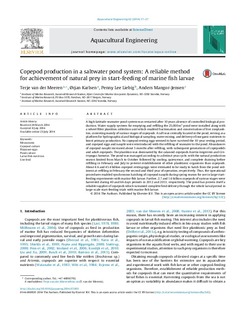Copepod production in a saltwater pond system: A reliable method for achievement of natural prey in start-feeding of marine fish larvae
Journal article, Peer reviewed
Permanent lenke
http://hdl.handle.net/11250/224786Utgivelsesdato
2014-07-23Metadata
Vis full innførselSamlinger
- Articles [3016]
Originalversjon
Terje van der Meeren, Ørjan Karlsen, Penny Lee Liebig, Anders Mangor-Jensen, Copepod production in a saltwater pond system: A reliable method for achievement of natural prey in start-feeding of marine fish larvae, Aquacultural Engineering, Volume 62, September 2014, Pages 17-27, ISSN 0144-8609, http://dx.doi.org/10.1016/j.aquaeng.2014.07.003. 10.1016/j.aquaeng.2014.07.003Sammendrag
A high-latitude seawater pond system was restarted after 10 years absence of controlled biological production. Water supply systems for emptying and refilling the 25,000 m3 pond were installed along with a wheel filter plankton collection unit which enabled fractionation and concentration of live zooplankton, consisting mainly of various stages of copepods. A raft was centrally located in the pond, serving as a platform for hydrographical and biological sampling, water mixing, and delivery of inorganic nutrients to boost primary production. No copepod resting eggs seemed to have survived the 10-year resting period, and copepod eggs and nauplii were reintroduced with the refilling of seawater to the pond. Abundances of copepod nauplii increased about 5 months after refilling, with subsequent generations of copepodids and adult copepods. The plankton was dominated by the calanoid copepods Acartia longiremis and Centropagus hamatus. The pond was managed according to a distinct year cycle, with the natural production season limited from March to October followed by cooling, quiescence, and complete draining before refilling in February and July to prevent establishment of other planktonic organisms than copepods. About 4.6 and 45.4 billion copepod resting eggs were estimated to be ready to hatch from the pond sediment at refilling in February the second and third year of operation, respectively. Thus, the operational procedures enabled synchronous hatching of copepod nauplii during spring season for use in large start-feeding experiments with marine fish larvae. Further, 2.7 and 1.6 billion copepods of various stages were harvested during 40 and 66 days periods in 2012 and 2013, respectively. The pond has proven itself a reliable supplier of copepods which sustained complete feed delivery through the whole larval period in large-scale start-feeding trials with marine fish larvae.

